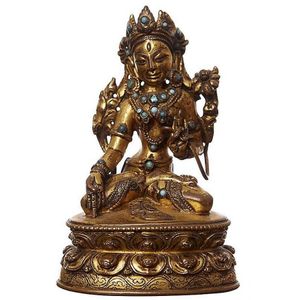14th/15th century Tibetan Gilt Bronze Green Tara Figure
You must be a subscriber, and be logged in to view price and dealer details.
Subscribe Now to view actual auction price for this item
When you subscribe, you have the option of setting the currency in which to display prices to $Au, $US, $NZ or Stg.
- Bronze - An alloy of copper and tin, traditionally in the proportions of about 9 parts of copper to 1 part of tin.
The discovery of bronze in Western Asia in the 4th century enabled people to create metal objects which were superior to those previoulsy possible because of its strength and hardness, and it has been used throughout the world for weapons, coins, tools, statuary and other decorative items.
It is very fluid in a molten state, and its hardness, strength when set, and non-corrosive properties makes it most suitable for casting sculpture. - Qing Dynasty - The Qing Dynasty was the last imperial dynasty of China, ruling from 1644 to 1912. It was established by the Manchu people, who originated from the northeastern region of China. The Qing Dynasty was preceded by the Ming Dynasty and followed by the Republic of China.
This item has been included into following indexes:
Visually similar items

A Tibetan gilt bronze white Tara, 16th century, the fire-gilded bronze with turquoise inlay, the right hand in Bhumispharsha mudra and holding a lotus in the left, seated on a double lotus throne, with sealed base, 10.5 cm high. Provenance: Cito Cessna, Pa

A Chinese gilt bronze white Tara Positioned in a seated meditating pose on a double lotus base, with lotus flowers rising above each shoulder. 22.5 cm high.

A fine Kassa Mala Kingdom gilt-bronze figure of Green Tara (Syamatara), circa 14th century, Seated in lalitasana on a double-lotus throne, a lotus branch at each shoulder, encrusted with semi-precious stones, the back of the throne painted ref (typical of

A Chinese gilt bronze Buddha, double-vajra mark to the base, 28.7 cm high
